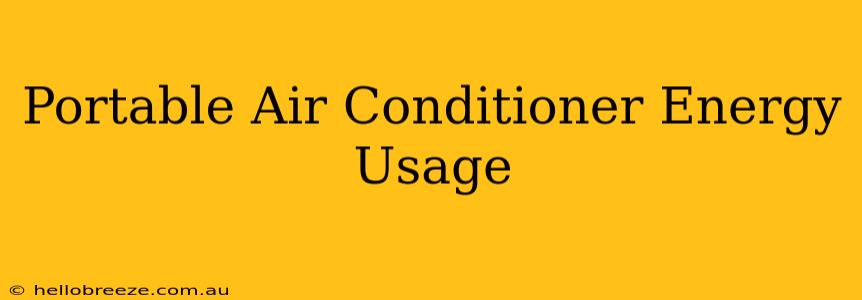Summer heat can be unbearable, and a portable air conditioner offers a refreshing solution. But before you plug one in, understanding its energy consumption is crucial. This guide delves into the energy usage of portable AC units, helping you make informed decisions and potentially save money on your energy bills.
How Much Energy Does a Portable Air Conditioner Use?
The energy consumption of a portable air conditioner varies significantly depending on several factors:
-
BTU Rating: The British Thermal Unit (BTU) rating indicates the cooling capacity. Higher BTU ratings mean more powerful cooling but also higher energy consumption. A 5,000 BTU unit will use less energy than a 14,000 BTU unit. Choose a BTU rating appropriate for the size of the room you're cooling. Oversizing can lead to wasted energy.
-
Energy Efficiency Ratio (EER): This metric measures the cooling output (BTUs) per hour divided by the watts of electricity consumed. A higher EER indicates greater energy efficiency. Look for units with a higher EER rating to minimize energy consumption.
-
Usage Habits: Leaving your portable AC running constantly will obviously consume more energy than using it intermittently. Using it only when needed, setting the thermostat efficiently, and utilizing features like a timer can significantly reduce energy use.
-
Room Insulation: A poorly insulated room will require the air conditioner to work harder and consume more energy to maintain a comfortable temperature. Improving insulation can drastically reduce energy usage.
-
Window Seal: A poorly sealed window can allow cool air to escape and hot air to enter, forcing your portable AC to work overtime. Ensure a proper seal around the window unit to maintain efficiency.
Tips for Reducing Portable Air Conditioner Energy Consumption
Several strategies can help you minimize the energy consumption of your portable air conditioner:
1. Choose the Right Size Unit:
Don't overestimate or underestimate the BTU rating. An undersized unit will struggle to cool the room effectively, leading to prolonged use. An oversized unit will cool the room too quickly, then cycle on and off frequently, which can also waste energy.
2. Optimize Your Settings:
Set the thermostat to a reasonable temperature. Each degree cooler increases energy consumption. Utilize the sleep or timer function to avoid unnecessary run time.
3. Regular Maintenance:
Keep the air filter clean. A clogged filter restricts airflow, forcing the compressor to work harder. Regular cleaning ensures optimal performance and energy efficiency.
4. Improve Room Insulation:
Consider adding window insulation film or curtains to reduce heat transfer. Proper insulation can significantly improve the efficiency of your portable AC unit.
5. Seal the Window:
Use weatherstripping or other sealing materials to prevent air leakage around the window where the portable AC exhaust vent is installed.
6. Consider Energy-Star Rated Units:
Energy Star certified units meet stringent energy-efficiency guidelines. Choosing an Energy Star unit ensures you are getting an energy-efficient model.
Calculating Your Energy Costs
To estimate your energy costs, consider these factors:
- Electricity Price: Check your electricity bill to find your per-kilowatt-hour (kWh) rate.
- AC Wattage: The wattage is usually found on the unit's specifications.
- Daily Run Time: Estimate how many hours per day you use the unit.
You can then use a simple calculation: (Wattage/1000) * kWh rate * Daily run time = Daily energy cost
Conclusion
Portable air conditioners offer convenient cooling, but understanding their energy usage is crucial for responsible consumption. By following these tips and choosing the right unit for your needs, you can enjoy cool comfort without significantly impacting your energy bill. Remember, making informed decisions about BTU rating, EER, and usage habits can lead to significant energy savings.

